Balbharti Maharashtra State Board Class 12 Geography Solutions
Chapter 4 Primary Economic Activities Textbook Exercise Questions and Answers.
1. Choose the correct option and complete the sentence.
Question 1.
The gathering of various products from the forests for livelihood is mainly carried in
(a) Temperate coniferous forests.
(b) Temperate deciduous forests.
(c) Tropical deciduous forests.
(d) Equatorial evergreen forests.
Answer:
(d) Equatorial evergreen forests.
Question 2.
Ideal location for fishing
(a) rugged coasts, shallow seas, hot climate, growth of planktons.
(b) shallow seas, confluence of warm and cold ocean currents, growth of planktons, cold climate.
(c) continental shelf, growth of planktons, good fishing skills, cold climate.
(d) continental shelf, rugged coasts, growth of planktons, cold climate.
Answer:
(b) shallow seas, confluence of warm and cold ocean currents, growth of planktons, cold climate.

Question 3.
Primary economic activities not related directly to latitudinal locations
(a) lumbering
(b) fishing
(c) mining
(d) agriculture
Answer:
(c) mining
Question 4.
Characteristics of extensive commercial agriculture
(a) monoculture, use of water, tropical, cereal production.
(b) monoculture, use of machinery, tropical cereal production.
(c) monoculture, use of manual labour, equator, Thailand, horticulture.
(d) monoculture, use of scientific know how, sub-tropical, production of pulses.
Answer:
(b) monoculture, use of machinery, tropical cereal production.
2. Complete the chain.
Question 1.
Answer:
3. Write short notes on.
Question 1.
Plantation agriculture
Answer:
Question 2.
Physical factors and fishing
Answer:
Development of fishing requires specific physical factors.
Therefore, it is developed on a commercial scale where physical factors are favourable for fishing.
The following are the important physical factors, which can be responsible for the development of fishing.
Question 3.
Lumbering on a commercial scale
Answer:
Commercial lumbering is well developed in coniferous forest region of Canada, North Western Europe and Soviet Union.
The important factors responsible for the development of commercial lumbering in the above areas are as follows.

Question 4.
Hunting and loss of ecosystem
Answer:
4. Give geographical reasons.
Question 1.
Agriculture is done on a large scale in India.
Answer:
Question 2.
Mining is developed in Chhota Nagpur plateau of India.
Answer:
Question 3.
Lumbering is developed on a large scale in Canada.
Answer:
Cool climate of Canada, well developed transport facilities for the movement of logs, use of machinery for logging, large demand in local and international market for paper and pulp industries, limited development of other economic activities due to extreme cold climate are the other factors responsible for lumbering in Canada.

Question 4.
Extensive agriculture is a commercial type of agriculture.
Answer:
Question 5.
Lumbering is practiced more in coniferous region than in tropical region.
Answer:
Question 6.
Hunting has been banned.
Answer:
5. Differentiate between.
Question 1.
Lumbering in Equatorial forests and Temperate forests.
Answer:
Question 2.
Plantation Agriculture and Extensive Commercial Agriculture
Answer:

Question 3.
Mining and Fishing
Answer:
6. Answer the following questions in detail.
Question 1.
What are the factors affecting commercial fishing?
Answer:
Following factors affect commercial fishing.
Question 2.
Write a note on Intensive Subsistence agriculture.
Answer:
Question 3.
Give characteristics of Market Gardening.
Answer:
The following are the characteristics of market gardening.

Question 4.
Write a note on the areas in the world practicing commercial animal husbandry.
Answer:
Question 5.
Mining is dependent on the extraction of naturally occurring minerals. Explain.
Answer:
Question 6.
Write in detail about the characteristics of primary economic activities.
Answer:
7. On an outline map of the world, show the following with appropriate symbols and prepare-an index.
Question 1.
(a) Dogger Bank fishing area.
(b) Area of lumbering in Asia.
(c) Area of animal husbandry in Australia.
(d) An area of agriculture in Europe.
(e) Mining area in Arabian Sea.
(f) Fishing area in South-West Atlantic Ocean.
Answer:
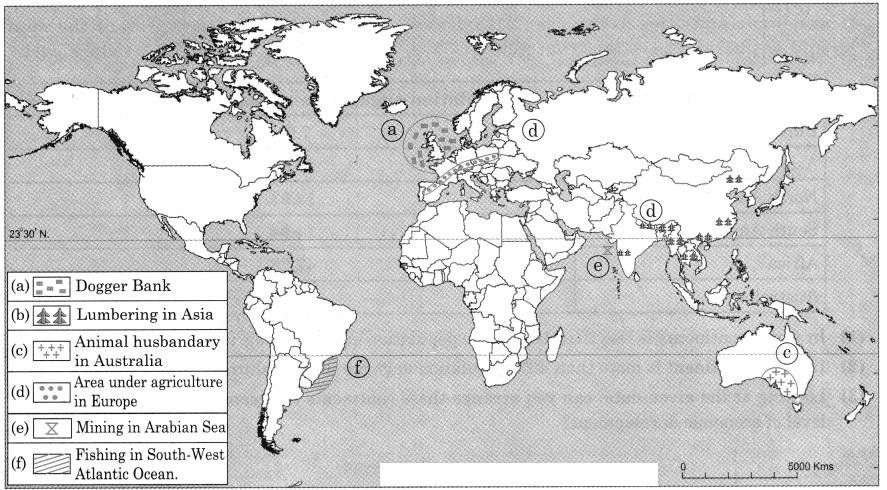
8. Given below is the data about the continent wise employment engaged in primary economic activities in the year 2018. Draw a suitable diagram to represent the data and answer the questions that follow
Question 1.
(1) In which continents is less than 10% of the population engaged in agriculture?
(2) In which continent is more than 40% population engaged in agriculture?
(3) Looking at the given data, can you arrange these continents in ascending order on the basis of level of economic development?
Answer:
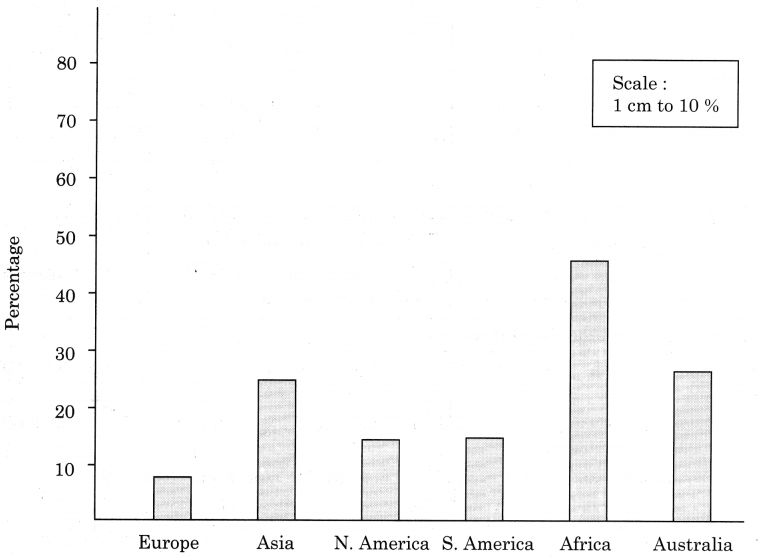
(1) In Europe less than 10% population is engaged in agriculture.
(2) In Africa more than 40% population is engaged in agriculture.
(3) Ascending order is as follows:
Africa, Asia, Australia, South America, North America, Europe

Class 12 Geography Chapter 4 Primary Economic Activities Intext Questions and Answers
Try this.
Question 1.
Complete the table. (Textbook Page No. 33)
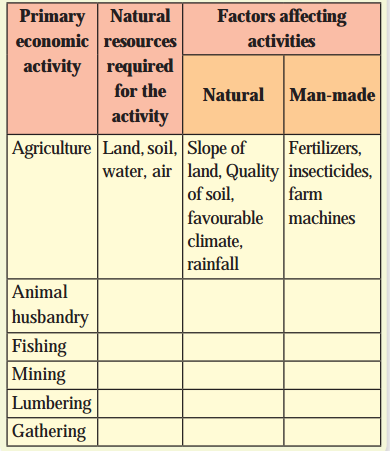
Answer:

Question 2.
Complete the chain by observing columns A to C. Write the number of the relevant characteristics and type of agriculture in column A. (Textbook Page Nos. 37-39)
Answer:

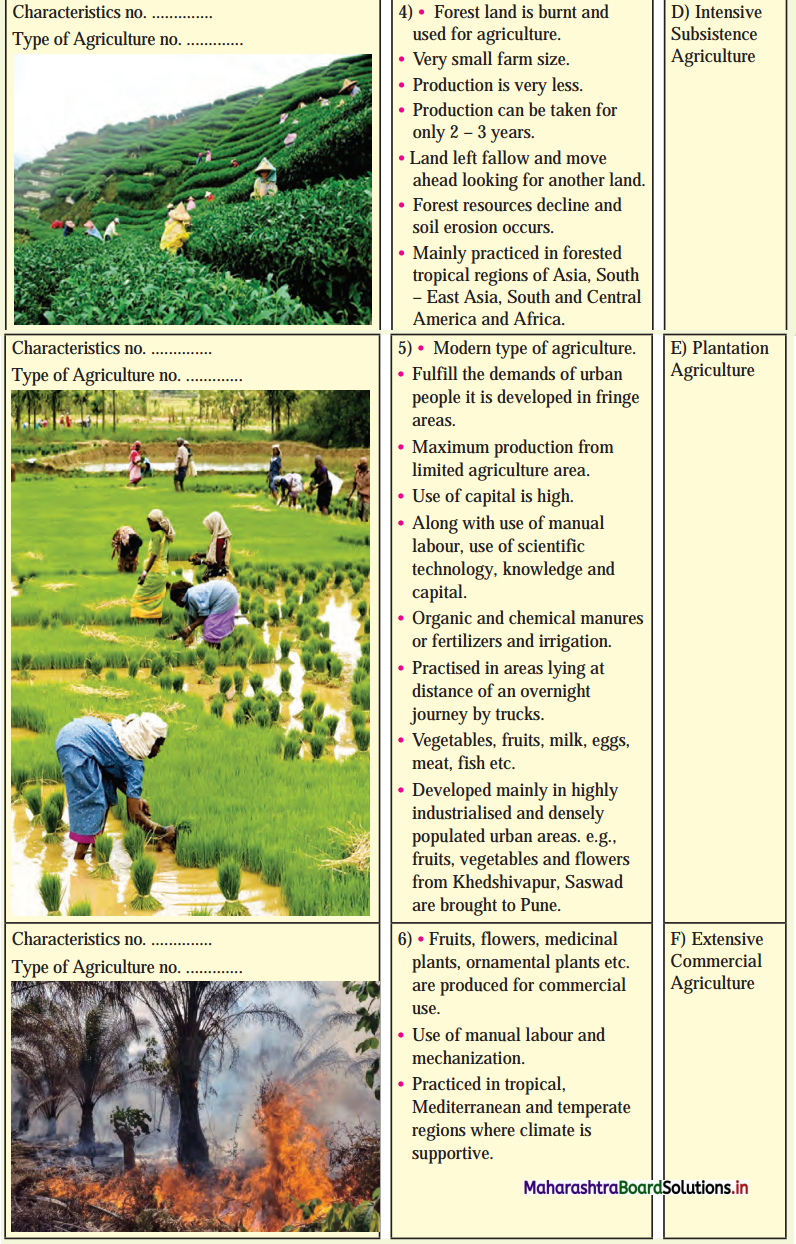
Question 3.
On the basis of the information given and pictures shown in textbook fig. classify the factors affecting agriculture into physical and human factors. (Textbook Page No. 39)
Answer:
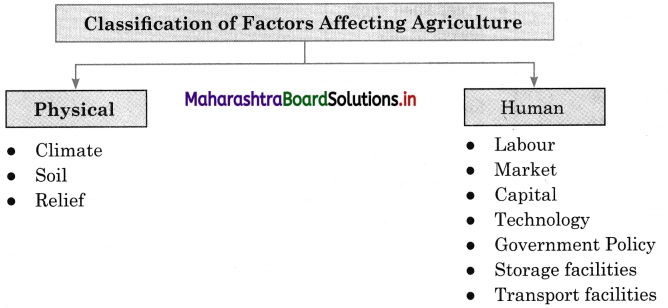
Give it a try.
Question 1.
Complete table. (Textbook Page No. 34)
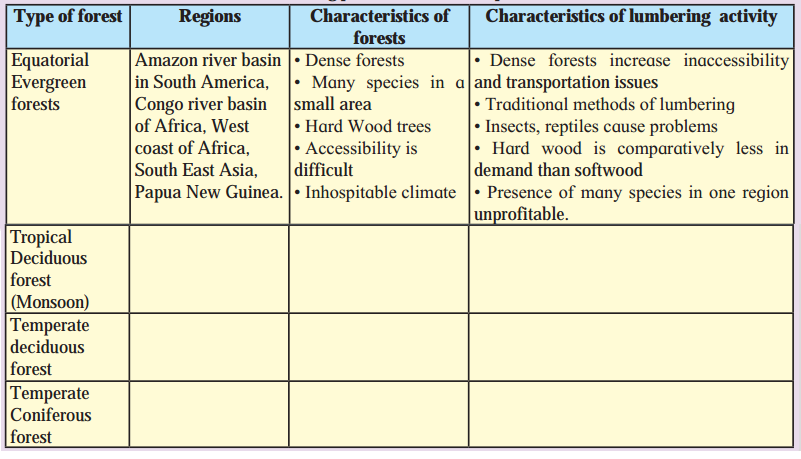
Answer:
Lumbering practiced in different parts of the world.
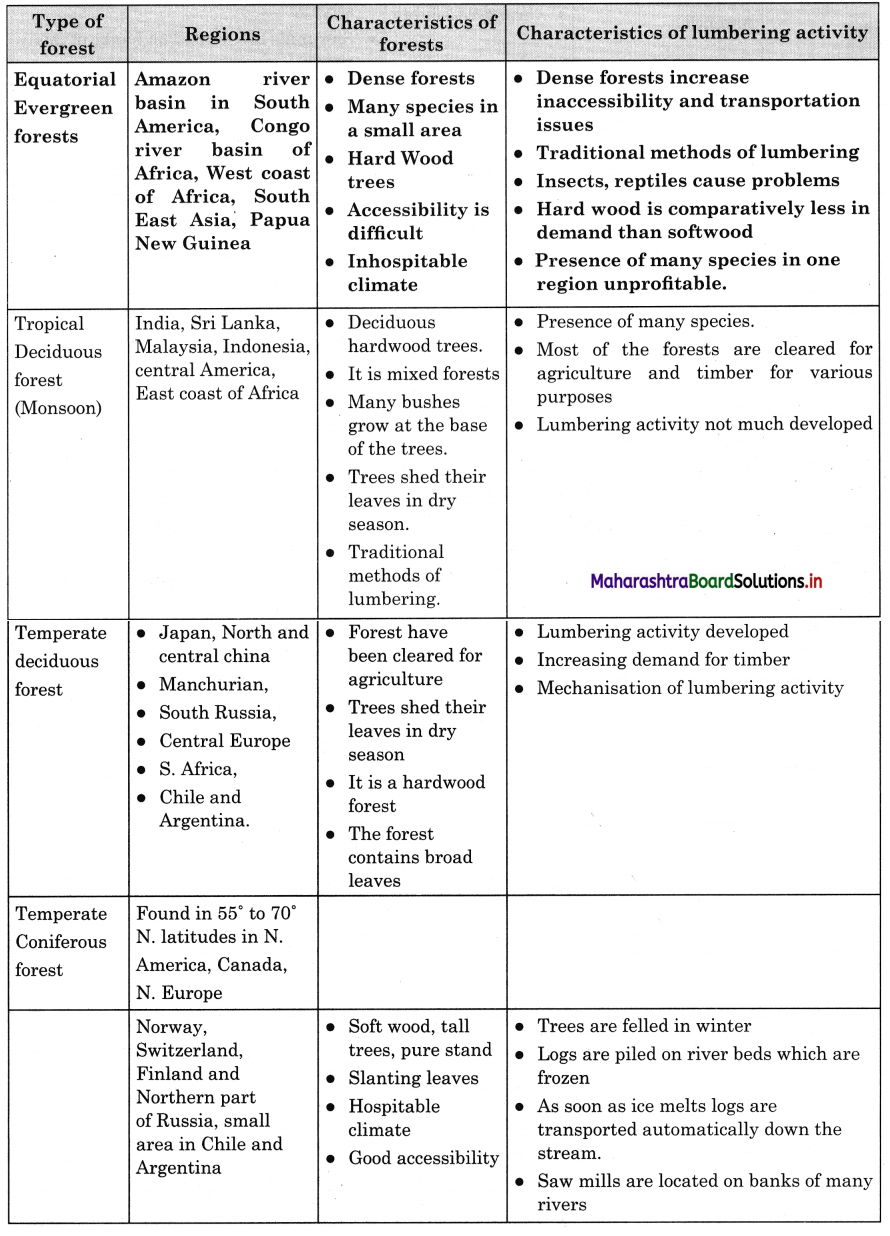

Make friends with maps!
Question 1.
Observe the map (Textbook Page No. 32) and answer the following questions (Textbook Page No. 33)
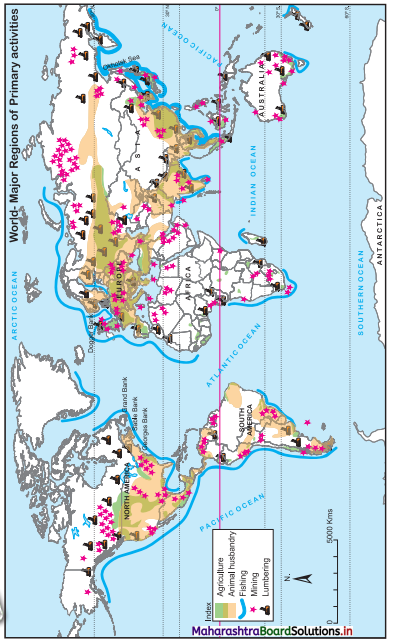
(i) Which economic activities are shown in the following map?
(ii) In which region do you don’t find any activity? what could be the reason?
(iii) In which latitudes do you primarily find the distribution of lumbering activity?
(iv) Why is fishing occupation only found in certain areas in the oceans?
(v) Which primary economic activities are mostly found in Europe?
(vi) What production does the symbol of mining shown in seas and oceans depict?
(vii) In which continent mining is not found?
(viii) In which ocean is the world’s fishing mostly carried out?
(ix) Which primary economic activities are found to the south of Tropic of Capricorn?
(x) Which primary activity is found in the islands of South East Asia?
(xi) Considering all four continents, in which continent do you find less agriculture being practiced?
(xii) Write a paragraph on relationship between latitudinal extent of agriculture and climate in your own words.
Answer:
(i) Agriculture, animal husbandry, fishing, mining and lumbering are the economic activities shown in the map.
(ii) In Antarctica region we do not find any activity because of permafrost and uninhabited continent.
(iii) Lumbering activity is primarily found in 50° to 70° North latitudinal region.
(iv) Fishing can develop only in those areas in the oceans where continental shelf is broad and shallow, meeting of cold and warm ocean water currents and availability plankton food for fish, cool climate etc. Since these physical factors are found only certain areas, so fishing occupation is developed in certain areas only. For example, Dogger banks in Europe or Grand Banks in north eastern part of USA etc.
(v) Agriculture, lumbering, mining and animal husbandry are the primary economic activities found in Europe.
(vi) A star (★) symbol for mining is shown for the production of mining in seas and oceans.
(vii) Mining is not found in the continent of Antarctica.
(viii)The world’s fishing is mostly carried out in the Atlantic Ocean.
(ix) Agriculture, mining, fishing, lumbering and animal husbandry are the primary economic activities found to the south of Tropic of Capricorn.
(x) Agriculture, fishing, and lumbering are the economic activities found in the islands of South East Asia.
(xi) Out of the four continents less agriculture is practiced in the continent of Australia.
(xii) Considering latitudinal extent except North Africa agricultural activities are important economic activities in latitudinal belt 8° to 50° North parallel of latitudes in the northern hemisphere and 20° to 45° latitudes in the southern hemisphere.
Can you tell?
Question 1.

(i) Identify the images given in fig. (Textbook Page No. 34)
(ii) What are these products made from?
(iii) What do you find the raw material that are required to make these products.
(iv) What is the occupation of obtaining these products called?
Answer:
(i) Honey, brush, chewing gum, tendu leaves, rope, broom, ornament and wild fruits images are given in photograph.
(ii) These products are made from nature.
(iii) The raw material required is coconut coir, rubber, tendu trees, honeybee and wood.
(iv) The occupation is called food gathering.
Question 2.
List out the effects of deforestation on the environment, animals, birds and humans. (Textbook Page No. 35)
Answer:
Some of the important problems are as follows.

Find out.
Question 1.
With the help of internet, find out about Wild Life (Conservation) Act. (Textbook Page No. 33)
Answer:
Wildlife Protection Act, 1972 and Amendment in 1991.
(i) Objective of the Act is to protect the wild animals, birds and plants particularly the endangered or threatened species.
(ii) The Act prohibits the capturing, killing, poisoning or trapping of wild animals.
(iii) A national wildlife action plan has been made under it.
(iv) The Act envisages the creation and management of sanctuaries and national parks.
(v) A section has also been incorporated for creation of Biosphere Reserves.
The objectives and components of the Act are as follows:
In 1991, the Act was amended to include plants in its definition of wildlife. Until then, for almost two decades, protection of plant life was not on agenda.
Question 2.
Find out how over exploitation of all kinds of animal resources affect human lives and environment. (Textbook Page No. 36)
Answer:
Question 3.
Mining causes air, water, land and noise pollution on large scale. Look for one example each. (Textbook Page No. 37)
Answer:
Think about it.
Question 1.
What is the difference between fishing and pisciculture? (Textbook Page No. 36)
Answer:

Question 1.
Observe the given map in fig. (Textbook Page No. 32) and answer the following questions. (Textbook Page No. 34)
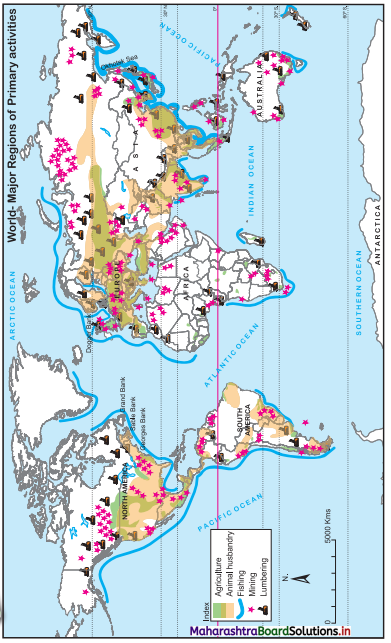
(i) Which countries in the monsoon region practice lumbering on large scale.
(ii) In which part of Australia is lumbering carried on?
(iii) Why do you think lumbering is not carried out in the Northern part of Africa?
(iv) Write a note on relationship between latitudes and lumbering.
(v) Why lumbering is not developed on commercial level in Equatorial region?
Answer:
(i) India, Myanmar, Nepal, Cambodia, Vietnam and Philippines.
(ii) In south western and south eastern part of Australia lumbering is carried on.
(iii) Lumbering is not carried in Northern part of Africa because it is covered by Sahara Desert.
(iv) Lumbering is practiced in the areas where forest grows.
(v) Commercial lumbering is not developed in Equatorial region due to following reasons.
Question 2.
Observe the map in figure. (Textbook Page No. 32) and answer the questions given below. (Textbook Page No. 35)
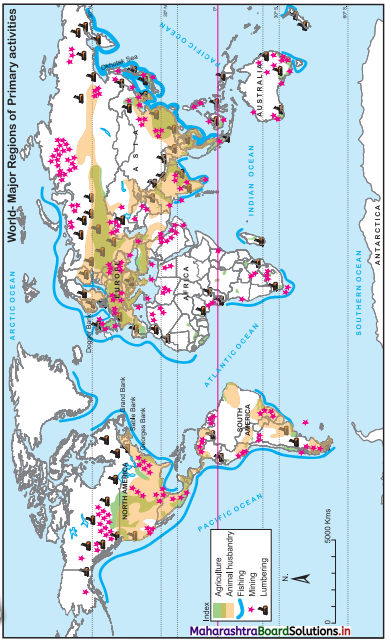
(i) Along which bank of North America is Grand bank located?
(ii) Along which coast of South America is the fishing mostly practiced?
(iii) In which part of Australian continent fishing activity developed?
(iv) Fishing is carried on large scale on the western coast of Africa than on the eastern coast of Africa. Give reasons.
(v) Commercial fishing is practiced on the southern coastline of Greenland. Give reasons.
Answer:
(i) Along North-Eastern bank of North America Grand bank is located.
(ii) Along the Western coast of South America fishing is mostly practiced.
(iii) Along South Eastern part of Australian continent fishing activity is developed.
(iv) Along the western coast of Africa, the continental shelf is broad and water is shallow.
(v) The southern coastline is the traditional area of fishing in Greenland.
Question 3.
Look at the map in fig. (Textbook Page No. 32) and answer the following questions. (Textbook Page No. 36)
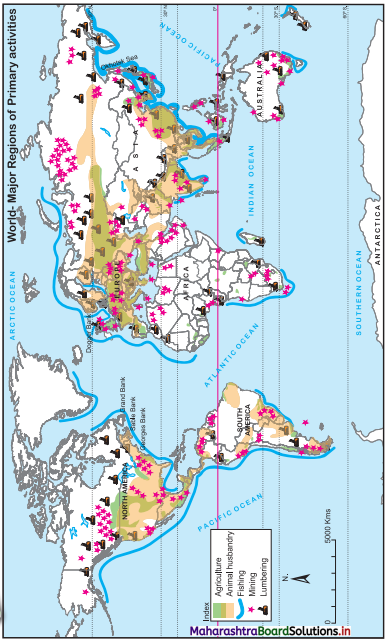
(i) Do you think there is correlation between animal husbandry and grassland?
(ii) In which continent animal husbandry not practiced on large scale?
(iii) In which regions of the world do animal husbandry and agriculture coincide?
(iv) Animal husbandry is found in between which latitude of the world?
(v) In which zone between 30°North to 30°South latitudes, is animal husbandry not found on large scale? What could be the reason behind.
(vi) What could be the reason of concentration of animal husbandry in the eastern part of Australia?
(vii) Why is animal husbandry developed more in the arid regions of the interior of the continents?
Answer:
(i) Yes, there is correlation between animal husbandry and grassland because animals are grazed on grassland.
(ii) In Africa continent animal husbandry not practiced on large scale.
(iii) In North America, Europe and Asia animal husbandry and agriculture coincide.
(iv) Animal husbandry is found between 30° North to 60° North and 30° South to 55° South.
(v) In a zone between 5° North to 5° South latitudes, animal husbandry is not found on large scale. This zone has equatorial climate, so dense forest growth and inhospitable climate and lack of good quality grass are the reasons for no development of animal husbandry in above mentioned zone.
(vi) For the development of animal husbandry, climate is more important factor. In eastern part of Australia, the climate is suitable for the growth of good quality grass, therefore, animal husbandry is more developed.
(vii) The arid regions of interior of the continents receive very low rainfall.
Question 4.
Look at the Fig. (Textbook Page No. 32) and answer the following questions (Textbook Page No. 36 and 37)
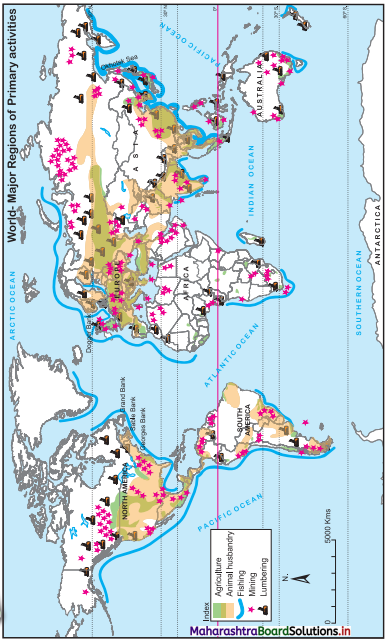
(i) In which part of North American continent is mining mainly found?
(ii) Mining activity is located along which coastal side of South America?
(iii) Comparing other primary economic activities, do you think the extent of mining is related to latitude.
(iv) Looking at the concentration of mining in the world, can you relate it with the economic development of the country?
Answer:
(i) Along North Eastern and Western coastline of USA and South Western part of Canada.
(ii) Northern, Western and Southern coastline of South America.
(iii) No, the extent of mining is not related to latitude.
(iv) Yes, we can relate mining with economic development of the country because minerals provide raw material to many industries, especially heavy industries. Therefore, countries rich in minerals have more economic development. For example, USA, Developed countries of Europe.
Chapter 4 Primary Economic Activities Textbook Exercise Questions and Answers.
1. Choose the correct option and complete the sentence.
Question 1.
The gathering of various products from the forests for livelihood is mainly carried in
(a) Temperate coniferous forests.
(b) Temperate deciduous forests.
(c) Tropical deciduous forests.
(d) Equatorial evergreen forests.
Answer:
(d) Equatorial evergreen forests.
Question 2.
Ideal location for fishing
(a) rugged coasts, shallow seas, hot climate, growth of planktons.
(b) shallow seas, confluence of warm and cold ocean currents, growth of planktons, cold climate.
(c) continental shelf, growth of planktons, good fishing skills, cold climate.
(d) continental shelf, rugged coasts, growth of planktons, cold climate.
Answer:
(b) shallow seas, confluence of warm and cold ocean currents, growth of planktons, cold climate.

Question 3.
Primary economic activities not related directly to latitudinal locations
(a) lumbering
(b) fishing
(c) mining
(d) agriculture
Answer:
(c) mining
Question 4.
Characteristics of extensive commercial agriculture
(a) monoculture, use of water, tropical, cereal production.
(b) monoculture, use of machinery, tropical cereal production.
(c) monoculture, use of manual labour, equator, Thailand, horticulture.
(d) monoculture, use of scientific know how, sub-tropical, production of pulses.
Answer:
(b) monoculture, use of machinery, tropical cereal production.
2. Complete the chain.
Question 1.
| A | B | C |
| (1) Intensive subsistence agriculture | (1) Dogger bank | (1) Small size of farm |
| (2) Pampas grassland region | (2) Off shore oil and gas production | (2) Unfavourable Climate |
| (3) Fishing | (3) Rice | (3) Bombay high |
| (4) Gathering | (4) Dense forest | (4) NE Atlantic Ocean |
| (5) Mining | (5) Commercial animal husbandry | (5) South America |
| A | B | C |
| (1) Intensive subsistence agriculture | (1) Rice | (1) Small size of farm |
| (2) Pampas grassland region | (2) Commercial animal husbandry | (2) South America |
| (3) Fishing | (3) Dogger bank | (3) NE Atlantic Ocean |
| (4) Gathering | (4) Dense forest | (4) Unfavourable Climate |
| (5) Mining | (5) Off shore oil and gas production | (5) Bombay high |
Question 1.
Plantation agriculture
Answer:
Question 2.
Physical factors and fishing
Answer:
Development of fishing requires specific physical factors.
Therefore, it is developed on a commercial scale where physical factors are favourable for fishing.
The following are the important physical factors, which can be responsible for the development of fishing.
Question 3.
Lumbering on a commercial scale
Answer:
Commercial lumbering is well developed in coniferous forest region of Canada, North Western Europe and Soviet Union.
The important factors responsible for the development of commercial lumbering in the above areas are as follows.

Question 4.
Hunting and loss of ecosystem
Answer:
4. Give geographical reasons.
Question 1.
Agriculture is done on a large scale in India.
Answer:
Question 2.
Mining is developed in Chhota Nagpur plateau of India.
Answer:
Question 3.
Lumbering is developed on a large scale in Canada.
Answer:
Cool climate of Canada, well developed transport facilities for the movement of logs, use of machinery for logging, large demand in local and international market for paper and pulp industries, limited development of other economic activities due to extreme cold climate are the other factors responsible for lumbering in Canada.

Question 4.
Extensive agriculture is a commercial type of agriculture.
Answer:
Question 5.
Lumbering is practiced more in coniferous region than in tropical region.
Answer:
Question 6.
Hunting has been banned.
Answer:
5. Differentiate between.
Question 1.
Lumbering in Equatorial forests and Temperate forests.
Answer:
| Equatorial Forests | Temperate Forests |
| (i) It is a tropical evergreen forest. | (i) It is a temperate coniferous forest. |
| (ii) It is mixed forest. | (ii) One species of trees are found over an extensive area. |
| (iii) Wood is hard. | (iii) Wood is soft. |
| (iv) Hot and humid climate, suitable for labour. | (iv) Cool and pleasant climate is suitable for labour. |
| (v) Surface movement difficult. | (v) Surface movement not difficult. |
| (vi) Mechanisation not possible for cutting trees. | (vi) Mechanisation is used for cutting trees. |
| (vii) No demand in local market. | (vii) Local market well developed. |
Plantation Agriculture and Extensive Commercial Agriculture
Answer:
| Plantation Agriculture | Extensive Commercial Agriculture |
| (i) Developed in tropical region. | (i) Developed in temperate region. |
| (ii) Labour intensive farming. | (ii) Machinery is more used. |
| (iii) Only crops are grown. | (iii) Commercial animal rearing is also done along with farming. |
| (iv) Tea coffee, cocoa spices are important crops. | (iv) Wheat and maize are important crops. |
| (v) This type of agriculture is practiced in Malaysia, India, Sri Lanka, Indonesia, etc. | (v) This type of agriculture is practiced in temperate grasslands of North America, South America, Europe and Asia. |
| (vi) Crops for export purpose. | (vi) Crops for export purposes. |

Question 3.
Mining and Fishing
Answer:
| Mining | Fishing |
| (i) Since ancient times man is using minerals as raw material. | (i) Since ancient time man is using fish as a food. |
| (ii) Found naturally in crust of the earth. | (ii) Found naturally but in rivers, lakes, seas and oceans. |
| (iii) Used as industrial raw materials. | (iii) Used as a food. |
| (iv) Highly uneven distribution. | (iv) Found everywhere in waterbodies. |
| (v) Availability of minerals depends upon geological structure. | (v) Availability of fish depends on nature of coast line, cool climate, cold and warm ocean water currents etc. |
Question 1.
What are the factors affecting commercial fishing?
Answer:
Following factors affect commercial fishing.
Question 2.
Write a note on Intensive Subsistence agriculture.
Answer:
Question 3.
Give characteristics of Market Gardening.
Answer:
The following are the characteristics of market gardening.

Question 4.
Write a note on the areas in the world practicing commercial animal husbandry.
Answer:
Question 5.
Mining is dependent on the extraction of naturally occurring minerals. Explain.
Answer:
Question 6.
Write in detail about the characteristics of primary economic activities.
Answer:
7. On an outline map of the world, show the following with appropriate symbols and prepare-an index.
Question 1.
(a) Dogger Bank fishing area.
(b) Area of lumbering in Asia.
(c) Area of animal husbandry in Australia.
(d) An area of agriculture in Europe.
(e) Mining area in Arabian Sea.
(f) Fishing area in South-West Atlantic Ocean.
Answer:

8. Given below is the data about the continent wise employment engaged in primary economic activities in the year 2018. Draw a suitable diagram to represent the data and answer the questions that follow
Question 1.
| Continent | % of population engaged in primary economic activities |
| Europe | 7.91 |
| Asia | 24.49 |
| North America | 14.93 |
| South America | 14.94 |
| Africa | 47.28 |
| Australia | 27.79 |
(2) In which continent is more than 40% population engaged in agriculture?
(3) Looking at the given data, can you arrange these continents in ascending order on the basis of level of economic development?
Answer:

(1) In Europe less than 10% population is engaged in agriculture.
(2) In Africa more than 40% population is engaged in agriculture.
(3) Ascending order is as follows:
Africa, Asia, Australia, South America, North America, Europe

Class 12 Geography Chapter 4 Primary Economic Activities Intext Questions and Answers
Try this.
Question 1.
Complete the table. (Textbook Page No. 33)

Answer:

Question 2.
Complete the chain by observing columns A to C. Write the number of the relevant characteristics and type of agriculture in column A. (Textbook Page Nos. 37-39)
Answer:


Question 3.
On the basis of the information given and pictures shown in textbook fig. classify the factors affecting agriculture into physical and human factors. (Textbook Page No. 39)
Answer:

Give it a try.
Question 1.
Complete table. (Textbook Page No. 34)

Answer:
Lumbering practiced in different parts of the world.


Make friends with maps!
Question 1.
Observe the map (Textbook Page No. 32) and answer the following questions (Textbook Page No. 33)

(i) Which economic activities are shown in the following map?
(ii) In which region do you don’t find any activity? what could be the reason?
(iii) In which latitudes do you primarily find the distribution of lumbering activity?
(iv) Why is fishing occupation only found in certain areas in the oceans?
(v) Which primary economic activities are mostly found in Europe?
(vi) What production does the symbol of mining shown in seas and oceans depict?
(vii) In which continent mining is not found?
(viii) In which ocean is the world’s fishing mostly carried out?
(ix) Which primary economic activities are found to the south of Tropic of Capricorn?
(x) Which primary activity is found in the islands of South East Asia?
(xi) Considering all four continents, in which continent do you find less agriculture being practiced?
(xii) Write a paragraph on relationship between latitudinal extent of agriculture and climate in your own words.
Answer:
(i) Agriculture, animal husbandry, fishing, mining and lumbering are the economic activities shown in the map.
(ii) In Antarctica region we do not find any activity because of permafrost and uninhabited continent.
(iii) Lumbering activity is primarily found in 50° to 70° North latitudinal region.
(iv) Fishing can develop only in those areas in the oceans where continental shelf is broad and shallow, meeting of cold and warm ocean water currents and availability plankton food for fish, cool climate etc. Since these physical factors are found only certain areas, so fishing occupation is developed in certain areas only. For example, Dogger banks in Europe or Grand Banks in north eastern part of USA etc.
(v) Agriculture, lumbering, mining and animal husbandry are the primary economic activities found in Europe.
(vi) A star (★) symbol for mining is shown for the production of mining in seas and oceans.
(vii) Mining is not found in the continent of Antarctica.
(viii)The world’s fishing is mostly carried out in the Atlantic Ocean.
(ix) Agriculture, mining, fishing, lumbering and animal husbandry are the primary economic activities found to the south of Tropic of Capricorn.
(x) Agriculture, fishing, and lumbering are the economic activities found in the islands of South East Asia.
(xi) Out of the four continents less agriculture is practiced in the continent of Australia.
(xii) Considering latitudinal extent except North Africa agricultural activities are important economic activities in latitudinal belt 8° to 50° North parallel of latitudes in the northern hemisphere and 20° to 45° latitudes in the southern hemisphere.
Can you tell?
Question 1.

(i) Identify the images given in fig. (Textbook Page No. 34)
(ii) What are these products made from?
(iii) What do you find the raw material that are required to make these products.
(iv) What is the occupation of obtaining these products called?
Answer:
(i) Honey, brush, chewing gum, tendu leaves, rope, broom, ornament and wild fruits images are given in photograph.
(ii) These products are made from nature.
(iii) The raw material required is coconut coir, rubber, tendu trees, honeybee and wood.
(iv) The occupation is called food gathering.
Question 2.
List out the effects of deforestation on the environment, animals, birds and humans. (Textbook Page No. 35)
Answer:
Some of the important problems are as follows.

Find out.
Question 1.
With the help of internet, find out about Wild Life (Conservation) Act. (Textbook Page No. 33)
Answer:
Wildlife Protection Act, 1972 and Amendment in 1991.
(i) Objective of the Act is to protect the wild animals, birds and plants particularly the endangered or threatened species.
(ii) The Act prohibits the capturing, killing, poisoning or trapping of wild animals.
(iii) A national wildlife action plan has been made under it.
(iv) The Act envisages the creation and management of sanctuaries and national parks.
(v) A section has also been incorporated for creation of Biosphere Reserves.
The objectives and components of the Act are as follows:
In 1991, the Act was amended to include plants in its definition of wildlife. Until then, for almost two decades, protection of plant life was not on agenda.
Question 2.
Find out how over exploitation of all kinds of animal resources affect human lives and environment. (Textbook Page No. 36)
Answer:
Question 3.
Mining causes air, water, land and noise pollution on large scale. Look for one example each. (Textbook Page No. 37)
Answer:
Think about it.
Question 1.
What is the difference between fishing and pisciculture? (Textbook Page No. 36)
Answer:

Question 1.
Observe the given map in fig. (Textbook Page No. 32) and answer the following questions. (Textbook Page No. 34)

(i) Which countries in the monsoon region practice lumbering on large scale.
(ii) In which part of Australia is lumbering carried on?
(iii) Why do you think lumbering is not carried out in the Northern part of Africa?
(iv) Write a note on relationship between latitudes and lumbering.
(v) Why lumbering is not developed on commercial level in Equatorial region?
Answer:
(i) India, Myanmar, Nepal, Cambodia, Vietnam and Philippines.
(ii) In south western and south eastern part of Australia lumbering is carried on.
(iii) Lumbering is not carried in Northern part of Africa because it is covered by Sahara Desert.
(iv) Lumbering is practiced in the areas where forest grows.
(v) Commercial lumbering is not developed in Equatorial region due to following reasons.
Question 2.
Observe the map in figure. (Textbook Page No. 32) and answer the questions given below. (Textbook Page No. 35)

(i) Along which bank of North America is Grand bank located?
(ii) Along which coast of South America is the fishing mostly practiced?
(iii) In which part of Australian continent fishing activity developed?
(iv) Fishing is carried on large scale on the western coast of Africa than on the eastern coast of Africa. Give reasons.
(v) Commercial fishing is practiced on the southern coastline of Greenland. Give reasons.
Answer:
(i) Along North-Eastern bank of North America Grand bank is located.
(ii) Along the Western coast of South America fishing is mostly practiced.
(iii) Along South Eastern part of Australian continent fishing activity is developed.
(iv) Along the western coast of Africa, the continental shelf is broad and water is shallow.
(v) The southern coastline is the traditional area of fishing in Greenland.
Question 3.
Look at the map in fig. (Textbook Page No. 32) and answer the following questions. (Textbook Page No. 36)

(i) Do you think there is correlation between animal husbandry and grassland?
(ii) In which continent animal husbandry not practiced on large scale?
(iii) In which regions of the world do animal husbandry and agriculture coincide?
(iv) Animal husbandry is found in between which latitude of the world?
(v) In which zone between 30°North to 30°South latitudes, is animal husbandry not found on large scale? What could be the reason behind.
(vi) What could be the reason of concentration of animal husbandry in the eastern part of Australia?
(vii) Why is animal husbandry developed more in the arid regions of the interior of the continents?
Answer:
(i) Yes, there is correlation between animal husbandry and grassland because animals are grazed on grassland.
(ii) In Africa continent animal husbandry not practiced on large scale.
(iii) In North America, Europe and Asia animal husbandry and agriculture coincide.
(iv) Animal husbandry is found between 30° North to 60° North and 30° South to 55° South.
(v) In a zone between 5° North to 5° South latitudes, animal husbandry is not found on large scale. This zone has equatorial climate, so dense forest growth and inhospitable climate and lack of good quality grass are the reasons for no development of animal husbandry in above mentioned zone.
(vi) For the development of animal husbandry, climate is more important factor. In eastern part of Australia, the climate is suitable for the growth of good quality grass, therefore, animal husbandry is more developed.
(vii) The arid regions of interior of the continents receive very low rainfall.
Question 4.
Look at the Fig. (Textbook Page No. 32) and answer the following questions (Textbook Page No. 36 and 37)

(i) In which part of North American continent is mining mainly found?
(ii) Mining activity is located along which coastal side of South America?
(iii) Comparing other primary economic activities, do you think the extent of mining is related to latitude.
(iv) Looking at the concentration of mining in the world, can you relate it with the economic development of the country?
Answer:
(i) Along North Eastern and Western coastline of USA and South Western part of Canada.
(ii) Northern, Western and Southern coastline of South America.
(iii) No, the extent of mining is not related to latitude.
(iv) Yes, we can relate mining with economic development of the country because minerals provide raw material to many industries, especially heavy industries. Therefore, countries rich in minerals have more economic development. For example, USA, Developed countries of Europe.